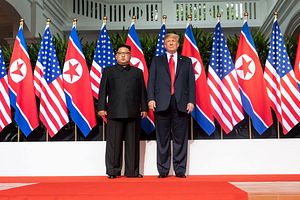As U.S. President Donald Trump and North Korean leader Kim Jong Un prepare to meet in Hanoi, Vietnam later this month, much attention is being paid to whether North Korea will take concrete actions toward dismantling its nuclear weapons program. By nearly all accounts, negotiations are in their early stages, but there is uncertainty over where they will go and what they can achieve. Part of the uncertainty comes from poor communication and past misunderstandings between the United States and North Korea. As a small but critical step toward improving communications channels and building trust, Trump should make opening a U.S. liaison office in Pyongyang a priority for the upcoming summit.
The current state of U.S.-North Korea relations is a relic of the Cold War. The two countries have no formal diplomatic relations. Their main communication channel is through the North Korean mission to the United Nations in New York City (although there is also a channel through their intelligence services). Americans in North Korea must rely on the Swedish embassy there for consular services.
This might have made sense in the time period following World War II and the Korean War, when countries picked a Korea to recognize based on ideological affinity. In the 70 years since, both Koreas have developed relations with states historically aligned with the other Korea. Now, North Korea has diplomatic relations with 164 countries, including some of America’s closest allies. It has been a full member of the United Nations since 1991. The absence of formal relations between the United States and North Korea is now the exception, not the rule.
The lack of a formal outpost makes it harder for U.S. and North Korean officials to interpret each other’s actions and political developments. If the countries must rely on backchannels and media statements to figure out what the other is thinking, there will naturally be gaps in understanding — gaps that could impede diplomatic progress. As the two countries look to “establish new U.S.-DPRK relations in accordance with the desire of the peoples of the two countries for peace and prosperity,” a liaison office would be an easy way to improve information flows and interpersonal relations between the countries.
A liaison office would mark the first-ever U.S. diplomatic mission in North Korea. It would create a space for working-level U.S. and North Korean officials to convene about key issues in the relationship, much as the U.S. liaison office in Vietnam did prior to the normalization of relations. As negotiations with North Korea proceed, these U.S. diplomats would be able to work directly with their North Korean counterparts to clarify policy positions and implement agreements reached by their leaders. Big, bold moves like denuclearization can’t occur without trust; regular, face-to-face working-level meetings are small but powerful mechanisms for establishing and nurturing the kind of confidence that is at the core of diplomacy.
The United States also has other interests in North Korea that it could more effectively pursue with regular diplomatic contact and would also serve as confidence-building opportunities. These include facilitating the returns of Korean War POW/MIA remains, establishing family reunions for North Korean and Korean American families, and delivering humanitarian aid.
Beyond these benefits, staffing a liaison office would also reduce the chances of a misunderstanding that could threaten the fragile détente of U.S.-North Korea relations. If there were an accidental clash between North Korean soldiers and UN command, or a mishap in joint U.S.-South Korea military exercises, having U.S. representatives in place could prevent escalation. When Trump was threatening to rain “fire and fury” on North Korea in 2017, it would have reduced tensions to have U.S. diplomats on deck to explain the president’s remarks and off-the-cuff rhetorical style.
Of course, setting up a liaison office will not be without logistical challenges. Given North Korea’s advanced cyber capabilities and dire human rights situation, the State Department’s Bureau of Diplomatic Security will likely be concerned with the safety of U.S. diplomats and U.S. information in North Korea. Liaison offices are also inherently reciprocal; North Korea would be able to open its own offices in Washington, D.C. Establishing these offices will involve negotiations over what diplomats are and are not allowed to do in each country. However, these issues should not stop the United States from pursuing a liaison office. The United States should turn to Sweden, Canada, and Germany to learn best practices for stationing diplomats in North Korea and for monitoring North Korean activity on the homefront.
The United States’ relationship with North Korea is long overdue for a diplomatic upgrade, and a liaison office would be a small but powerful step toward better relations. Although critics might argue that establishing informal diplomatic relations sends the wrong message, a liaison office does not mean that the United States accepts North Korea as a nuclear power or that it endorses the Kim regime – it just means that the United States is ready to regularly engage with North Korea, much as it does with hundreds of other countries (including other authoritarian dictatorships and nuclear weapons states that are not party to the Treaty on the Non-Proliferation of Nuclear Weapons). If the United States wants to make progress with North Korea, it needs to station diplomats on the frontlines.
Abby Bard is a research associate for National Security and International Policy at the Center for American Progress.































